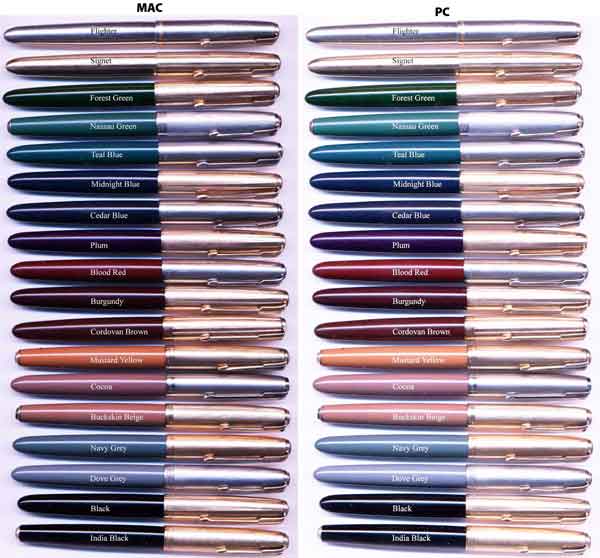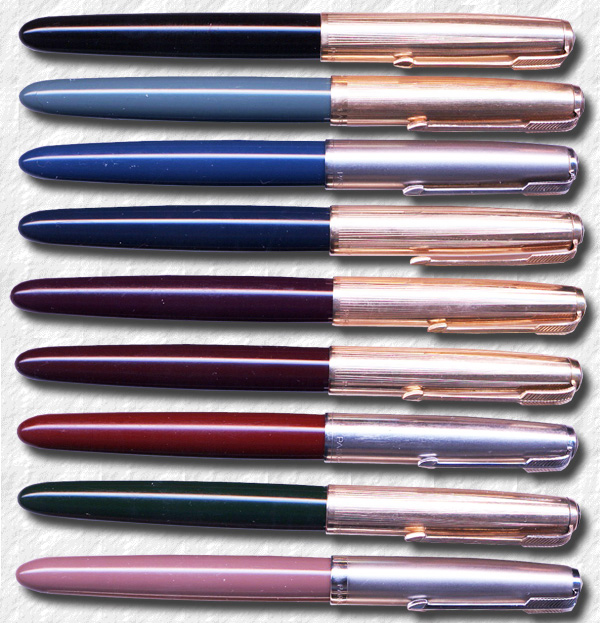
| parkerpens.net |
| PARKERCOLLECTOR.COM |
 |
The colours of the Vacumatic Parker 51's and the Aerometric Parker 51's. |
|
The Parker "51" Mark II is probably the most functional fountain pen ever made. It never leaks, always works and never breaks, well almost... It also, in my humble opinion, is one of the nicest pen designs ever made. It was the first pen that had the nib under a hood, the thought behind this was not to let the ink have a chance of drying on the way from the ink reservoir to the paper. |
There are two easy ways to date the early Parker "51" . First, starting in 1943, the year of making was printed at the bottom of the tubular nib, but of course dating from the nib is inexact at best, as the nib is one of the most frequently replaced parts. Secondly an imprint can be found on the top of the barrel, just under the cap clutch ring: PARKER "51" 6 MADE IN U.S.A. The small digit denotes the year of making for the barrel. This digit was deleted on the US made pens in 1953 but continued until 1959 on European (and Canadian?) pens, the same for the date on the nib. |
 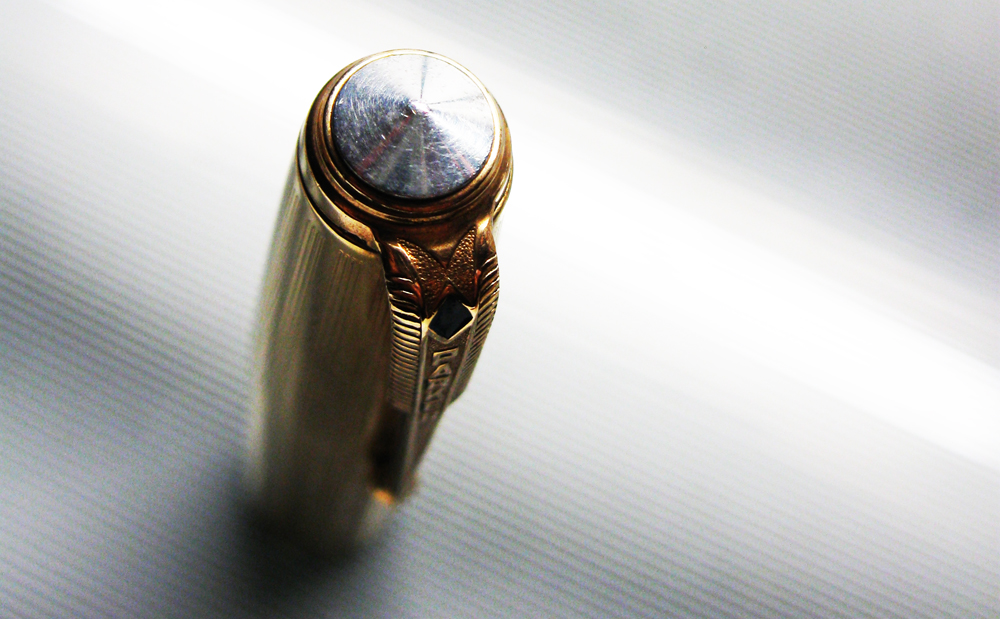 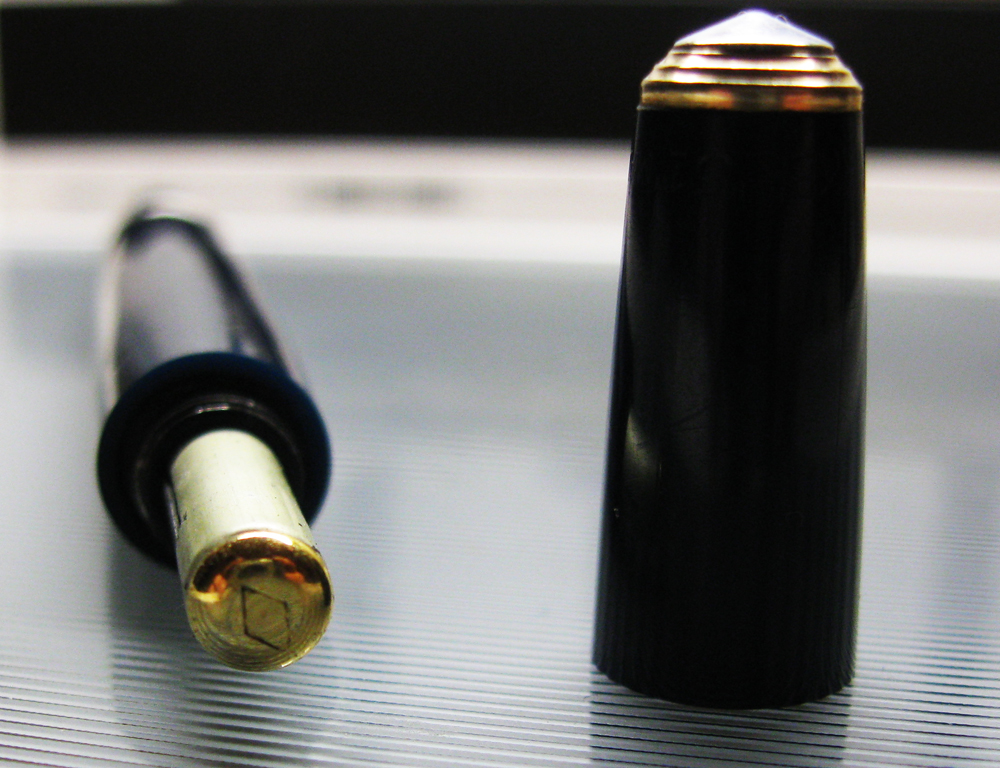 |
A "First Year" Parker "51" in Cedar Blue. from the first quarter of 1941. Note the distict features, Double aluminium jewels, metal filler with diamond imprint. |
The Parker "51" came in 4 basic different styles. There's been some confusion, since David Shepherd chose in this book "Parker 51" not to count the Vacumatic filler as MK I, instead starting with the first aerometric model. It might become grounds for confusion, but In this article the Vacumatic filler will be referred to as the MK I, the Aerometric with the rounded end as the MK II, the aerometric with the plastic jeweled "61" style cap and squarish end as the MK III and the aerometric with the metal jeweled "61" style cap as the MK IV. To complicate things further there's also a MK I-B, a transitional Vacumatic filler with the new style non-blue diamond cap with a long clip. The MK II can also be divided into MK II-A, with the longer clip cap, (identical to the MK I-B), the MK II-B with a shorter clip and MK II-C with an even shorter clip with fewer feathers and the "halo" logo on the cap. |
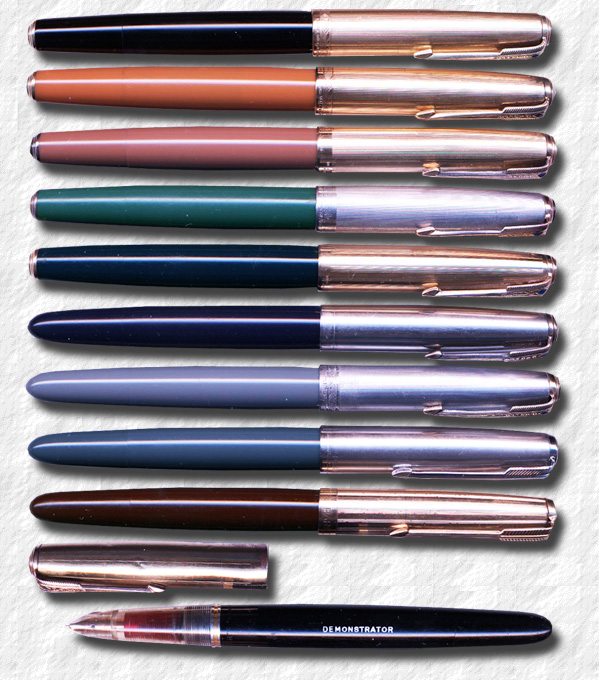 |
The colours of the vacumatic filler Parker "51": |
|
Mark I (1942-48), had the (late) Vacumatic filling system with a plastic plunger hidden behind a blind cap. It also had the arrow clip with the blue diamond design previously added to the the Vacumatics in 1939. From 1943 the nib was date coded. The Mark I Parker "51" came in seven colours: |
|
|
The Parker "51" aerometrics: Black, Navy Grey, Teal Blue, Midnight Blue, Plum, Burgundy, Blood Red, Forest Green and Cocoa. |
|
|
In late 1947 Parker in Newhaven, UK, started to produce Vacumatic filler Parker "51"'s, although no double jewelled pens were offered and the pens only came in the colours of India Black, Cedar Blue, Dove Grey and Cordovan Brown. But, like in the US, vacumatic fillers in Navy Grey has surfaced (there are also some examples of US-made Burgundy vacumatic filler Parker 51's.) These anomalies are most likely the result of pens having been sent back to Parker for repair, and since there were no more old stock, vacumatic filler sections and bodies were made from later aerometric coloured stock. These are relatively rare, especially the Burgundy. |

|
Two Vacumatic filled Parker "51" in Dove Grey |
|
In 1947 a court ruled in the US that products could no longer be sold with a life-time guarantee. Parker decided to discontinue the Blue Diamond on the clips. The new clip was very similar to the early Vacumatic clips but was longer. The clip is often referred to as the "transitional clip and the pens could be categorised as the MK I-B. Both transitional and blue diamond clips clips offered until 1948, while Parker cleaned out old stock. These clips were also fitted to all vacumatic filler parker 51's made in the UK, no English blue diamond caps were produced. |
The MKII pens of course had a brand new filling system that was to be adopted by virtually all Parkers in the future, the Aerometric. Almost all pens had to have moving parts (well, all until the Parker 61) to make the filling easy. Most European pens had screw or pump plungers (Mont Blanc, Pelikan etc) while the American pen companies preferred rubber sacs with different levers or plungers. These rubber sacs inevitably rotted away in time due to the acid in the ink. When this happened a lot of clothes got destroyed and the pen companies all had special departments that delt with paying for clothes ruined by their product. |
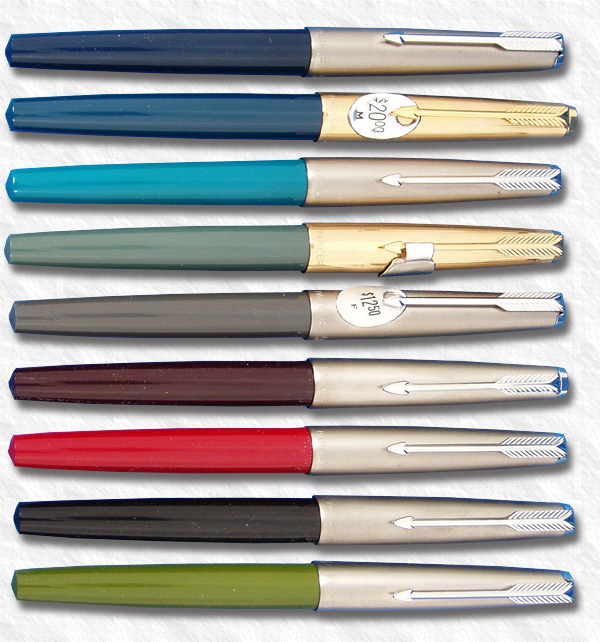
Image © Ernesto Soler courtesy of Parker51.com |
A collection of Parker "51" MKIII/IV in standard and uncommon colours. |
|
The barrel colours were:
|
Also in 1948 The Parker "51" Signet was introduced with an all GF cap and barrel with vertical lines. It changed name to Insignia in 1957 and both names are used by collector's. In 1949 the Parker "51" Presidential was introduced in solid gold. The Demi pens were not made in this style. From 1950 the single "year" digit on the body became 2 digits. "MADE IN U.S.A. 50" Also in 1950 the Parker "51" Flighter was introduced. This pen was made of steel with GF trim and survided until 1960. In the late 1950's the gold cap ring was deleted from the Flighter pen. |
|
A Signet/Insignia and a Flighter Parker "51". |
|
Another Parker "51" was also added to the series in 1950, the Parker "51" Special. This had the aerometric filling system but in the manner of the Demi "51" with a U-shaped pressure bar. The big difference was that it sported an octanium (eight metal alloy) nib rather than one made of gold and it came with a shiny chrome cap only (the Standard Parker "51" were made in a matte chrome design). The cap jewel or clip screw, was made in black (while the Standard had a pearl coloured plastic)The "51" Special initially came in four colours, Green being a later fifth addition to the line.
Black
Grey
Burgundy
Blue
Green. |
|

Images © 2012 and courtesy of Tsachi Mitsenmacher. |
Parker "51" Cartridge filler. |
|
Mark IV (Early 1970's-mid 1970's) Still looked a lot like the Parker 61. Cap screw now in metal, section ring wider again. |
In 2002 Parker launched a retro model, the Parker "51" Special Edition in one of its rarest finishes, the Empire State Building etched cap. Read more about the great "51" in David and Mark Shepherds book "Parker 51" |

Images © 2012 and courtesy of Tsachi Mitsenmacher. |
Maybe the most sought for caps of the Parker "51", |

Images © 2012 and courtesy of Tsachi Mitsenmacher. |
Perhaps rarer than the above caps are the "Fish Scale" caps in Solid gold. |
 Images © Andreas Lambrou courtesy of http://www.classicpensinc.com/ |
A fantastic collection of double-jewelled Vacumatic filler Parker "51" 's" with rare caps. |
© 1995-2019 Tony Fischier and The Parker Pen Company®/Sanford Ecriture.
This page is in no way sponsored by or created by the Parker Pen Company®. All opinions, views, and thoughts expressed herein are expressly the authors, and in no way reflect the opinions, views, or thoughts of the Parker Pen Company®/Sanford Ecriture. All logos and/or images on these pages are © Copyright of Parker Pen Company®Sanford Ecritureunless otherwise stated and is reprinted by kind permission. If You feel that Your copyright has been violated please contact the WEBMASTER.
Everything on this website is copyrighted by law and can not be used without written permission from the author, Tony Fischier. You may however use the information as reference material and although it is forbidden to make digital copies or reproductions it may be physically printed for personal use, which does not include use on other web pages or in advertising. You may however quote parts of the content of this website, digitally or physically, providing that the source and author is clearly stated, together with the copyright information. In the US referred to as Fair use. If you use any information on this site, add a link.
Feel free to donate a small sum through Paypal to help this site to stay online. Acknowledgements.
Parkercollector.com in translated versions
